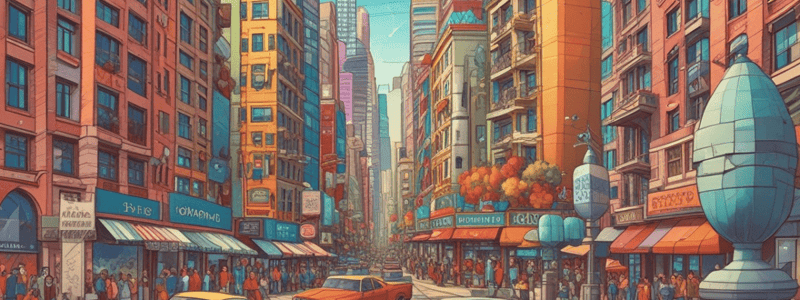Podcast
Questions and Answers
In the long run, oligopolists can earn normal profits by creating entry barriers.
In the long run, oligopolists can earn normal profits by creating entry barriers.
False (B)
What is the purpose of limit pricing?
What is the purpose of limit pricing?
to prevent new firms from entering an industry
When output reaches QB, the fixed stock of ______________ is fully employed.
When output reaches QB, the fixed stock of ______________ is fully employed.
capital
Match the following entry barriers with their descriptions:
Match the following entry barriers with their descriptions:
Why does the firm fix the price at its profit-maximizing level?
Why does the firm fix the price at its profit-maximizing level?
The average variable costs can be constant over a large range.
The average variable costs can be constant over a large range.
What is the normal-capacity output?
What is the normal-capacity output?
The fixed factor in the production process is divisible because some of it can be left __________________.
The fixed factor in the production process is divisible because some of it can be left __________________.
What happens to the output when demand fluctuates between slump and boom?
What happens to the output when demand fluctuates between slump and boom?
In the long run, oligopolists can earn supernormal profits by creating entry barriers.
In the long run, oligopolists can earn supernormal profits by creating entry barriers.
What is an example of an entry barrier created by oligopolists?
What is an example of an entry barrier created by oligopolists?
The firm fixes the price at its profit-maximizing level and builds a plant whose normal capacity is the __________________ output.
The firm fixes the price at its profit-maximizing level and builds a plant whose normal capacity is the __________________ output.
Match the following descriptions with their corresponding entry barriers:
Match the following descriptions with their corresponding entry barriers:
What happens to output when demand fluctuates between slump and boom?
What happens to output when demand fluctuates between slump and boom?
The fixed factor in the production process is always fully employed.
The fixed factor in the production process is always fully employed.
What is the purpose of creating entry barriers?
What is the purpose of creating entry barriers?
The average variable costs can be constant over a large range up to the point at which all of the fixed factor is __________________.
The average variable costs can be constant over a large range up to the point at which all of the fixed factor is __________________.
What is the reason for the firm to build a plant with a normal capacity of QN?
What is the reason for the firm to build a plant with a normal capacity of QN?
Flashcards are hidden until you start studying
Study Notes
Monopolistic Competition
- Characteristics:
- Large number of producers supplying slightly differentiated products
- Freedom of entry and exit
- Each firm has some control over the price of its product
- Product differentiation is often achieved or reinforced by branding and advertising
- Examples: retail clothing stores, restaurants, barber shops, etc.
- In the short run, firms earn supernormal profits, but in the long run, firms earn only normal profits
- Average cost of production is not minimized, resulting in excess capacity and higher average costs
- There is no optimal allocation of resources, and the price consumers pay does not equal the marginal cost of production
Oligopoly
- Definition: A market structure in which only a few firms account for most or all of total production
- Characteristics:
- Interdependence among firms
- Barriers to entry
- Non-price competition (advertising, product differentiation, etc.)
- Price rigidity
- Forms of oligopoly:
- Homogeneous products (e.g. cement, steel)
- Differentiated products (e.g. cars, cigarettes)
- Firms must consider the reactions of their rivals when making decisions
Collusion
- Definition: Agreements among firms to restrain market competition
- Types of collusion:
- Formal collusion (cartel): explicit agreements among firms
- Informal collusion (tacit collusion): implicit agreements among firms
- Characteristics of successful cartels:
- Inelastic demand
- Control over a substantial share of output
- Conducive political climate
- Examples of cartels: OPEC, copper cartel
Price Competition and Non-Price Competition
- Price competition: aggressive price-cutting to increase sales
- Non-price competition: advertising, product differentiation, warranties, etc.
- Examples of non-price competition:
- Advertising to differentiate products
- Extended guarantees and warranties
- Model and style changes
- Promotion offers (e.g. "two for the price of one")
Prisoner's Dilemma
- A game theory concept illustrating the problem of cooperation among oligopolistic firms
- Each firm has an incentive to cheat on agreements, leading to lower profits for all firms
- Firms may engage in price wars or aggressive competition instead of cooperating
Price Rigidity - Kinked Demand Curve Model
- A model explaining price rigidity in oligopolistic markets
- Firms believe that if they raise prices, their competitors will not follow, and if they lower prices, their competitors will follow
- The demand curve is kinked at the current price, with a discontinuous marginal revenue curve
- Firms are reluctant to change prices due to the perceived risk of price wars or loss of market share
Saucer-Shaped Average Variable Cost Curve Theory
- A theory explaining the flat shape of the average variable cost curve over a range of output
- Divisibility of the fixed factor allows for constant marginal and average variable costs over a range of output
- Example: a factory with 10 sewing machines, where output can be increased without changing the ratio of labor to machines
Monopolistic Competition
- Characteristics:
- Large number of producers supplying slightly differentiated products
- Freedom of entry and exit
- Each firm has some control over the price of its product
- Product differentiation is often achieved or reinforced by branding and advertising
- Examples: retail clothing stores, restaurants, barber shops, etc.
- In the short run, firms earn supernormal profits, but in the long run, firms earn only normal profits
- Average cost of production is not minimized, resulting in excess capacity and higher average costs
- There is no optimal allocation of resources, and the price consumers pay does not equal the marginal cost of production
Oligopoly
- Definition: A market structure in which only a few firms account for most or all of total production
- Characteristics:
- Interdependence among firms
- Barriers to entry
- Non-price competition (advertising, product differentiation, etc.)
- Price rigidity
- Forms of oligopoly:
- Homogeneous products (e.g. cement, steel)
- Differentiated products (e.g. cars, cigarettes)
- Firms must consider the reactions of their rivals when making decisions
Collusion
- Definition: Agreements among firms to restrain market competition
- Types of collusion:
- Formal collusion (cartel): explicit agreements among firms
- Informal collusion (tacit collusion): implicit agreements among firms
- Characteristics of successful cartels:
- Inelastic demand
- Control over a substantial share of output
- Conducive political climate
- Examples of cartels: OPEC, copper cartel
Price Competition and Non-Price Competition
- Price competition: aggressive price-cutting to increase sales
- Non-price competition: advertising, product differentiation, warranties, etc.
- Examples of non-price competition:
- Advertising to differentiate products
- Extended guarantees and warranties
- Model and style changes
- Promotion offers (e.g. "two for the price of one")
Prisoner's Dilemma
- A game theory concept illustrating the problem of cooperation among oligopolistic firms
- Each firm has an incentive to cheat on agreements, leading to lower profits for all firms
- Firms may engage in price wars or aggressive competition instead of cooperating
Price Rigidity - Kinked Demand Curve Model
- A model explaining price rigidity in oligopolistic markets
- Firms believe that if they raise prices, their competitors will not follow, and if they lower prices, their competitors will follow
- The demand curve is kinked at the current price, with a discontinuous marginal revenue curve
- Firms are reluctant to change prices due to the perceived risk of price wars or loss of market share
Saucer-Shaped Average Variable Cost Curve Theory
- A theory explaining the flat shape of the average variable cost curve over a range of output
- Divisibility of the fixed factor allows for constant marginal and average variable costs over a range of output
- Example: a factory with 10 sewing machines, where output can be increased without changing the ratio of labor to machines
Studying That Suits You
Use AI to generate personalized quizzes and flashcards to suit your learning preferences.




